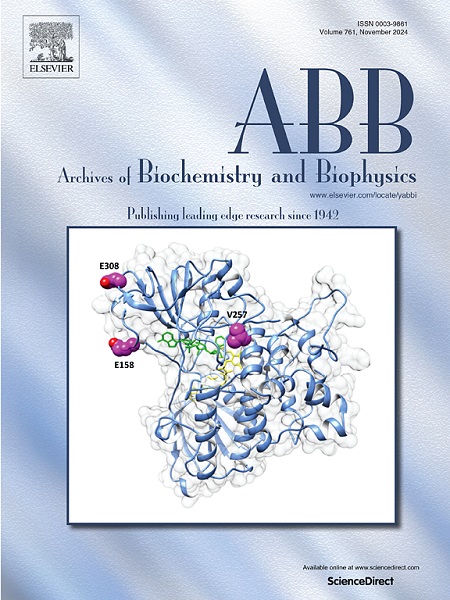解码KRAS动力学:探索突变和抑制剂结合的影响。
IF 3.8
3区 生物学
Q2 BIOCHEMISTRY & MOLECULAR BIOLOGY
引用次数: 0
摘要
KRAS(克尔斯滕大鼠肉瘤病毒癌基因同源物)是人类癌症中最常见的突变蛋白,是发病率和死亡率的主要原因。在Sotorasib (AMG-510)于2020年被批准用于非小细胞肺癌治疗之前,致癌KRAS突变被认为是非药物性的。有和没有抑制剂的gdp结合KRAS突变体的高分辨率x射线晶体结构。然而,为了开发针对致癌KRAS突变体的抑制剂,了解蛋白质构象的动力学和各自的结合位点是至关重要的。在本研究中,我们对野生型和突变型KRAS结构进行了多分子动力学(MD)模拟,以了解G12C或G12D突变如何导致活性状态的稳定,以及KRAS抑制剂如何将突变构象锁定在非活性状态。研究发现,当KRAS抑制剂AMG-510和MRTX1133分别结合到相应的Switch-II (S-II)口袋时,鸟苷二磷酸(GDP)结合的KRAS突变体G12C和G12D在稳定性方面被锁定在失活状态。与非共价抑制剂MRTX1133相比,共价抑制剂AMG-510更有效地锁定了失活的gdp结合KRASG12C突变体。位于配体4Å内的P-loop, Switch-I和Switch-II结构域的关键高动态氨基酸之间的Cα原子距离在结合抑制剂(AMG-510或MRTX1133)的KRAS突变体中是稳定的,但在整个微秒模拟中没有任何抑制剂时是动态的。根据每残基能量分解结果,与amg -510结合的KRASG12C和mrtx1133结合的KRASG12D相比,无抑制剂KRASG12C和KRASG12D中S-II氨基酸的能量值变化更大。例如,与amg -510结合的KRASG12C相比,无抑制剂的KRASG12C在S-II残基(即Thr58、Gln61、Glu63和Arg68)中表现出更高的能值变化。研究发现,AMG-510在扭转角上具有较高的稳定性是由于其与KRASG12C突变体结合的共价性质。S-II氨基酸,即Thr58、Glu63和Arg68在amg -510结合的KRASG12C中保持稳定。研究表明,AMG-510的结合显著稳定了其周围的氨基酸,超过了MRTX1133。在本研究中获得的见解有望在新的kras靶向药物的设计和开发中有用。本文章由计算机程序翻译,如有差异,请以英文原文为准。

Decoding KRAS dynamics: Exploring the impact of mutations and inhibitor binding
KRAS (Kirsten rat sarcoma viral oncogene homologue), the most common mutated protein in human cancers, is the leading cause of morbidity and mortality. Before Sotorasib (AMG-510) was approved for non-small cell lung cancer treatment in 2020, the oncogenic KRAS mutations were believed to be non-druggable. High-resolution X-ray crystal structures of GDP-bound KRAS mutants with and without inhibitor are resolved and deposited in the Protein Data Bank (PDB). Nevertheless, to develop inhibitors targeting oncogenic KRAS mutants, understanding the dynamics of protein conformations and respective binding sites is crucial. In the present study, multiple molecular dynamics (MD) simulations were conducted on wild-type and mutant KRAS structures to understand how G12C or G12D mutations lead to the stabilization of the active state and how KRAS inhibitors lock the mutated conformations in their inactive state. The study found that the guanosine diphosphate (GDP)-bound KRAS mutants, G12C and G12D, were locked in the inactive state, in terms of stability, when the KRAS inhibitors, AMG-510 and MRTX1133, respectively, bind to the respective Switch-II (S-II) pocket. Covalent inhibitor AMG-510 locked the inactive GDP-bound KRASG12C mutant more efficiently when compared to the non-covalent inhibitor MRTX1133. The Cα atom distance between key highly dynamic amino acids from P-loop, Switch-I, and Switch-II domains, lying within 4 Å of the inhibitor, were stable in the KRAS mutant with bound inhibitors (AMG-510 or MRTX1133), but were varying largely in the absence of any inhibitor throughout the microsecond simulation. According to the per-residue energy decomposition results, S-II amino acids in inhibitor-free KRASG12C and KRASG12D mutants showed larger variations in energy values as compared to AMG-510-bound KRASG12C and MRTX1133-bound KRASG12D, respectively. For example, the inhibitor-free KRASG12C exhibited larger variations in energy values in the S-II residues, namely, Thr58, Gln61, Glu63, and Arg68, as compared to the AMG-510-bound KRASG12C. The study found that the higher stability of AMG-510 in torsion angles was due to its covalent nature of binding to the KRASG12C mutant. The S-II amino acids, namely, Thr58, Glu63, and Arg68 remained stable in AMG-510-bound KRASG12C. The study showed that AMG-510 binding significantly stabilizes the amino acids surrounding it, surpassing that of MRTX1133. The insights gained in the present study is expected to be useful in the design and development of new KRAS-targeted drugs.
求助全文
通过发布文献求助,成功后即可免费获取论文全文。
去求助
来源期刊

Archives of biochemistry and biophysics
生物-生化与分子生物学
CiteScore
7.40
自引率
0.00%
发文量
245
审稿时长
26 days
期刊介绍:
Archives of Biochemistry and Biophysics publishes quality original articles and reviews in the developing areas of biochemistry and biophysics.
Research Areas Include:
• Enzyme and protein structure, function, regulation. Folding, turnover, and post-translational processing
• Biological oxidations, free radical reactions, redox signaling, oxygenases, P450 reactions
• Signal transduction, receptors, membrane transport, intracellular signals. Cellular and integrated metabolism.
 求助内容:
求助内容: 应助结果提醒方式:
应助结果提醒方式:


